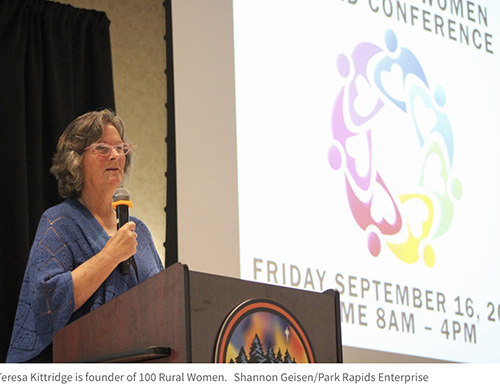In her years working with the Minnesota House of Representatives and the Rural Policy Research Institute, Teresa Kittridge consistently observed two issues that led her to launch 100 Rural Women: the lack of women in decision-making roles and the broad—and often inaccurate—brush with which rural communities are frequently painted.
 Kittridge says that although she was often the only woman in a room of powerful men, she was also fortunate to have found connections with women leaders who supported her.
Kittridge says that although she was often the only woman in a room of powerful men, she was also fortunate to have found connections with women leaders who supported her.
“Women lead projects all the time, but they aren’t often the ones who get to make the decisions about policy, investment, and other major topics,” Kittridge says. “I thought the only way we are going to change that picture and the picture of rural Minnesota is to have more representative leadership and greater collaboration.”
In 2019, Kittridge—who now lives 30 miles north of Grand Rapids in Marcell, Minnesota—formed 100 Rural Women, a nonprofit and non-partisan organization committed to building leadership and confidence through networking, mentoring, education, and civic engagement. She set about hosting 100 meetings in 100 days. “Our goal was to listen to women’s stories and understand what they need and come out of these meetings with 100 ideas,” she says.
“Women lead projects all the time, but they aren’t often the ones who get to make the decisions about policy, investment, and other major topics. I thought the only way we are going to change that picture and the picture of rural Minnesota is to have more representative leadership and greater collaboration.”
Teresa Kittridge
And then the pandemic struck. Kittridge quickly pivoted to being a virtual organization so as not to lose momentum. She knew a professor whose students were losing their internships because of Covid so she engaged these young women in her work. “We built 100 Rural Women with these young women and created ways for women to learn about each other’s journeys and to get and provide mentoring.”
A pre-survey asked women about barriers they faced. They then met for an hour to talk about strategies to deal with the barriers. Graduate students from the University of Minnesota facilitated the sessions and built the resulting data set to guide the organization’s steps. “We gave women a safe space to talk about what they need and came out of these 100 meetings with six themes about how we could help rural women build confidence and demystify paths to leadership,” Kittridge says.
-
Community
-
Safe Spaces
-
Emotional and Mental Health
-
Opportunities
-
Skills
-
Peer Support
Today, 100 Rural Women is building mentorship networks across all sectors, starting with civic leadership. Its “Ask a Leading Woman” series features women who serve as formal or informal leaders. “It’s so important for women to hear about other women’s journeys,” Kittridge says. “I want everyone to see a path.” Speakers have included artist and community organizer Moira Villiard; Vote Run Lead Minnesota senior state director Beth Peterson; Indigenous scholar and educator Colleena Bibeau; and St. Paul & Minnesota Foundation relationship manager Cheniqua Johnson. Breakfast webinars, a virtual book club, and a series of video spotlight profiles are expanding the reach of 100 Rural Women.
Kittridge notes that the members of her growing organization are diverse in terms of political views, socio-economic status, and race and ethnic identity. “We check our politics at the door and find something we can agree on and build trust. I believe women can provide the model we need for more collaborative leadership.”
She notes that her organization’s work is particularly needed in rural Minnesota. “We need young families to move to or stay in rural communities. And part of that is making sure that rural women have opportunities to thrive and lead.”
For more information, visit https://100ruralwomen.org/